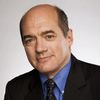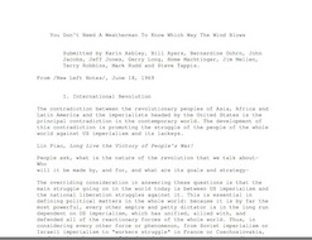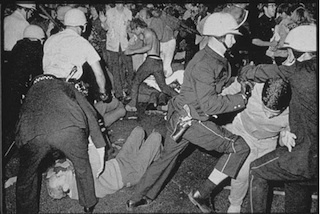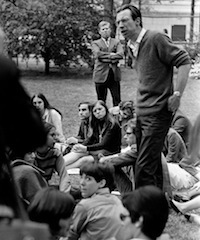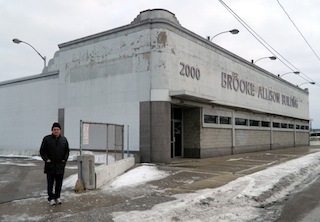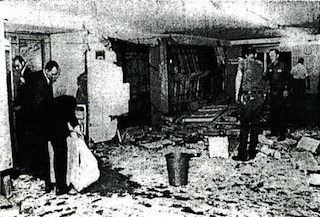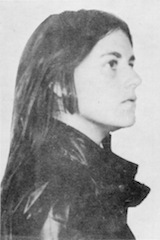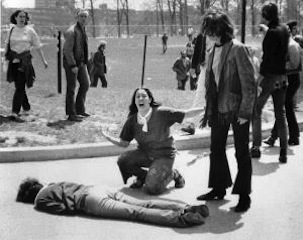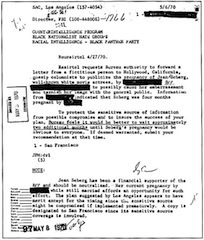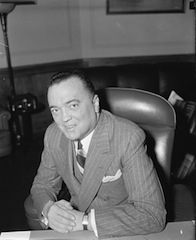Part Three: You Don't Need a Weatherman to Know Which Way the Wind Blows
In March 1969, my hero and mentor, Carl Oglesby was forced out as president of the Students for a Democratic Society (SDS) by a radical left-wing faction that had taken control of the organization. Some of the members were Red Diaper Babies--so called because of their rearing on Lenin, Marx and Fanon by former members of the Communist Party USA. These young Marxists swiftly took the SDS in a frightening and violent direction.
After forcing Carl out in March, SDS diverged to form the Revolutionary Youth Movement (RYM), including the Weatherman tendency. The RYM was a reaction to the Progressive Labor Party (PLP), which also formed the SDS split after the Chicago 1969 SDS National Convention. The Weatherman designated John " J.J." Jacobs as one of their leaders. J.J. co-authored a new manifesto, "You Don't Need a Weatherman to Know Which Way the Wind Blows," which was published in New Left Notes when the SDS National Convention opened in Chicago on June 18, 1969. The Weatherman manifesto stated that "the goal [of the revolution] is the destruction of U.S. imperialism and the achievement of a classless world: world Communism." It advocated a violent revolution and called upon SDS members to form collectives in the nation's major cities to support the struggle.
After the Chicago SDS convention, the Revolutionary Youth Movement splintered into two groups: RYM I, driven by Bernadine Dohrn; and the Revolutionary Youth Movement II, led by Mike Klonsky. Both groups positioned themselves against the Worker Student Alliance, which was the youth chapter of the Progressive Labor Party.
They both believed world imperialism needed to be destroyed. However, RYM I not recruit the working class, as they found the demographic hopeless, having been fundamentally influenced by corporations from the U.S. empire, as well as a white-skin privilege. Thus, they believed the revolutionary mass must be cultivated elsewhere--in youth.
Different from RYM I, the Revolutionary Youth Movement II viewed U.S. working class as difficult to motivate, but not impossible. They believed education to be the most effective catalyst for a revolution.
Politically, both RYM I and II took issue with what they alleged was PLP's opposition to the right of self-determination for oppressed nations and ethnic groups. They pointed to the PLP's attacks on the Vietnamese National Liberation Front, whom PLP accused of betraying the worldwide revolution by engaging in Paris Peace Talks with the U.S. RYM I and RYM II also opposed the PLP's attacks on the Black Panther Party. PLP found African-Americans within the Black Panther Party to be a super-exploited part of an exploited working class, and thus black nationalism was a bourgeois affectation and could not be supported.
At the time, however, I was blissfully unaware of the radicalization and splintering of what I thought was a pro-democracy pro-business SDS. As far as I was concerned, I was still the high school coordinator of SDS, a post Carl Oglesby had appointed me to in 1965. I had been the organization's junior high school coordinator from 1966-1968, and I took both my posts very seriously, despite my marginal impact.
Carl shared my conviction that, in the long term, a solid small-business community was the only hope for the United States to flourish. I had been encouraged by his positive feedback, and had been putting out a one-page quarterly that I thought was being sent out to the entire SDS membership by the national SDS office. Decades later, I learned that it was sent to several dozen teenagers on the mailing list.
At sixteen, I was deeply committed to the anti-war movement, so when my parents received a phone call from the National SDS office informing them that I was to receive an award for my work, on student strikes I was over the moon. The caller added that my strike model had been used successfully at Columbia University in New York City, and that I was a hero. I was invited to meet the SDS leadership to receive my award at a Howard Johnson Hotel on Miller Road in Flint.
Days of Rage (source)
I was excited and eager for recognition, and a little nervous, too. I was really looking forward to seeing Carl, who was not on speaking terms with my parents since leaving his wife. Although our families had once been very close, we hadn't seen Carl for eighteen months. One day, though, a package arrived for me with a note from Carl that only said "Be prepared." He had sent me Leon Trotsky's paper "The French Turn." He had also included the book What Is To Be Done? by Nikolai Chernyshevsky, which had influenced on Lenin, and a copy of Lenin's famous pamphlet "What Is To Be Done: Burning Questions of Our Movement."
I knew from my reading that Trotsky and Lenin were leaders of the Russian Revolution. I also knew that Trotsky had opposed Stalin, so he was driven out of the country and eventually murdered by an agent of that psychotic leader, Stalin. The French Turn was a tactic Trotsky urged his followers in France to use in the mid-1930s in order to radicalize their youth movement from within and to take over democratic organization.
At the time, I didn't understand why Carl had sent these materials to me--and I couldn't ask my parents because of their falling out with him.
My passionate, life-defining involvement with the SDS came to a shocking end on December 27, 1969. It was bitterly cold. I walked from the Unitarian Church up Miller Road to the Howard Johnson Restaurant where I was to receive my award. The SDS National Convention was beginning later that day and Carl had scheduled me as one of the speakers for the first day.
Carl speaking to a group of Anti-war protesters (source)
My mom waved to me as she entered Bill Knapp's parking lot across the street, embarrassing me but indulgently agreeing to wait there with my father in the parking lot. As I approached the Howard Johnson lobby, I saw J.J., whom I recognized him from his pictures. He was tall and incredibly good looking.
"Where's Carl?" I asked, as I started to unbutton my coat.
"Carl can't come. He's been removed," said J.J. "He is our hardworking assistant office manager," J.J. added mockingly.
I was stunned, although it did explain why I hadn't seen him for so long. After a moment, I squeaked out, "Am I still going to present at the convention?"
"Are you kidding me? No, you are not involved in any way," J.J. sneered, his eyes ablaze. "Your papers make me sick!" he ranted, adding, "they are capitalist garbage." His companions were silent.
"Wh-what?" I stammered, "I don't understand." Being the high school coordinator for the SDS had been such a huge part of my identity that I was having trouble processing.
J.J. threw a photograph at me. It was a picture of the Chicago police beating demonstrators during the Days of Rage in 1969. The photo was covered in what looked like dried blood.
I learned later that J.J. carried this picture with him wherever he went. I knew that he had been beaten recently at a demonstration. He was seething with rage and didn't seem altogether sane. In 1980, Carl revealed to me more details of J.J.'s behavior: on the flight to Flint, he had violently run up and down the aisle, knocking over people's food and drinks. Something was deeply wrong.
"The truth is here," J.J. announced, clutching a copy of New Left Notes. It was open to "You Don't Need to Be a Weatherman to Know Which Way the Wind Blows."
"You are bourgeois and spoiled--a loose cannon," he spat at me. "You are not to use the SDS letterhead or refer to us in any way. You're out. Don't ever contact us again."
"This is Leninist!" I yelled. "You can't do this, you don't have the authority. I know what you're doing! It's the French turn! And then, like the child I was, I blurted without thinking: "I am going to call the FBI!"
Without missing a beat J.J. said, " Do it, punk"
*****
The next four days were a disaster for the SDS. J.J. and his cohorts cut out other moderates and then held a series of meetings called "the Flint War Council" at an old dance hall on the corner of Hamilton and Saginaw streets. There, they abolished the SDS and declared guerrilla warfare against the U.S. government. During one of the meetings, a Weatherman defended the Sharon Tate murders; there was karate practice and group sex; in another meeting they discussed the possibility of murdering infants as part of justified revolutionary violence.
Hamilton and Saginaw Streets.
In January, the weatherman leadership destroyed the records of those most committed to the anti- draft and anti- war movement. The national SDS office located in Chicago was closed. The young revolutionaries named their new group The Weather Underground Organization (WUO) because some female members objected to the original name, "Weatherman", on the grounds that it was sexist. This turn of events was brutally executed by J.J. and the others, based on the very paper Carl had sent me--The Left Turn. It left the 100,000 responsible members of the SDS as confused and shocked as I was. Years later in his book Underground, Mark Rudd said of the take over, "The destruction of the SDS.... was a historical crime."
Despite this setback the national anti-war movement was able to generate millions of anti-war activists to demonstrate against this undeclared war. But the lack of a national student movement hurt us tremendously after the the Cambodia bombings and the Kent State shootings in 1970.
Back in Flint, I sank into a deep depression, feeling alone and realizing that everything for which Carl and I had worked came to nothing. We should have tried to use SDS to build as broad and powerful of an anti war movement as possible.
The aftermath of WUO's Pentagon bombing (source)
The WUO issued a "Declaration of a State of War" against the United States government and began orchestrating underground activities in hopes of sparking a revolution. The ultimate goal was to bring a Stalinist-type communist government to the US, including a plan to relocate American resistors to work camps. Starting in 197o, the WUO bombed the Capitol, the Pentagon, and several police stations in New York and many other sites. As J.J. predicted, they would "bring the war home." During periods of the 1960s, there was a bomb exploding every day somewhere in America.
Three members of the Weather Underground died when a bomb they were making in a Greenwich Village townhouse at 46 E 11th street exploded prematurely on March 6,1970.
Bernadine Dohrn (source).
Bernardine Dohrn was placed on the FBI's 10 Most Wanted List and became a fugitive. While on the run, she married another WUO leader, Bill Ayers, a former kindergarten teacher from Ann Arbor. The couple surrendered to police in 1980, stating concern for their two children. Today, she's an Associate Professor of Law at Northwestern University School of Law. In 1997, J.J. died from skin cancer in 1997 in Vancouver--still a fugitive.
After the Kent State shootings in 1970 (John Filo's Pulitzer-winning photo) (source)
After the 1971 public exposure of COINTELPRO by a dissident organization which broke into FBI headquarters outside Philadelphia, copying its internal plans for disrupting the antiwar movement. After publication of COINTELPRO plans, widespread criticism emerged of the illegal and undemocratic tactics used by COINTELPRO and the Red Squads. In 1978, Congress passed the Foreign Intelligence Surveillance Act (FISA, see), which placed limits on the power of police and Federal agencies, and ended the official use of Red Squads. The Director of COINTELPRO was fired by Hoover in 1971, and died during a tragic hunting accident in '79.
According to FBI documents obtained under the Freedom of Information Act, J. Edgar Hoover's budget for COINTELPRO was $50 million dollars per year. He had 100 full-time FBI agents assigned to the antiwar movement, plus some informants receiving payments of $300 dollars per month. Much of COINTELPRO's work, however, was to successfully undermine the horrific and brutal work of the Klu Klux Klan.
Clearly, Richard Nixon benefitted from these programs. He won the 1968 election due to media coverage of the Democratic National Convention. Individuals from the SDS party were involved in this event, but not the organization itself. As a result, he beat the antiwar candidate, Hubert Humphrey.
The October 1969 Days of Rage protests, incited by the WUO, only fueled Nixon's supporters and Nixon intensified U.S. involvement in the Vietnam War. This caused massive inflation, as the war was being financed by government increases in the money supply. In a nationally-televised address on August 15, 1971, Nixon announced price controls for the U.S. economy, making it illegal for the first time ever in this country to change prices or wages.
These totalitarian controls, which were supported by many economists, caused shortages and made many entrepreneurs fearful to start businesses--after all, they were not free to determine the most advantageous prices and wages. All of this so angered the "freedom community" that they led to the incorporation of the Libertarian Party in December of 1971 by David Nolan in Colorado. But that is another story.
J. Edgar Hoover.
I'm glad to see a new generation of students organizing to effect political change, and I hope you will all study and learn from the lessons of your predecessors in the 1960s. So many of our nation's current foreign policy and internal security issues are rooted in what happened then so this is a story that hasn't been told.
